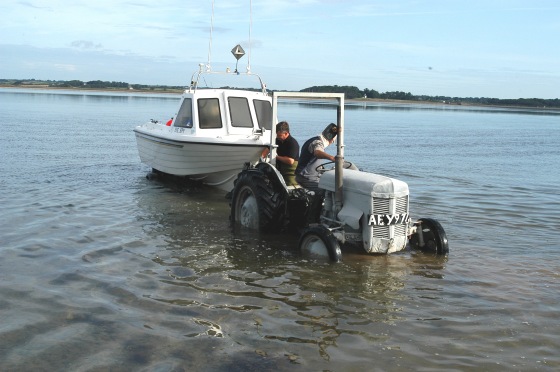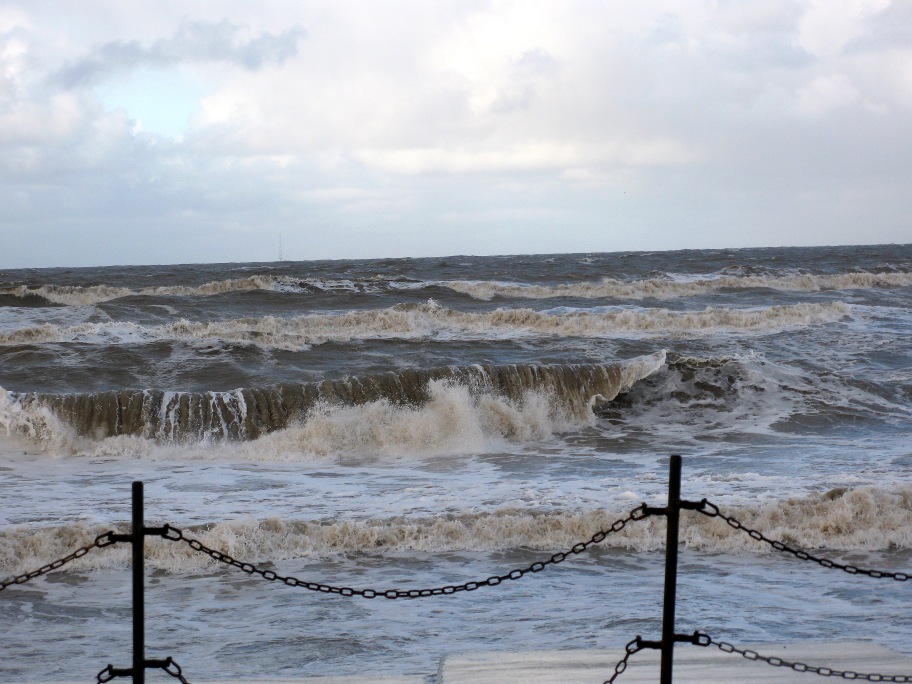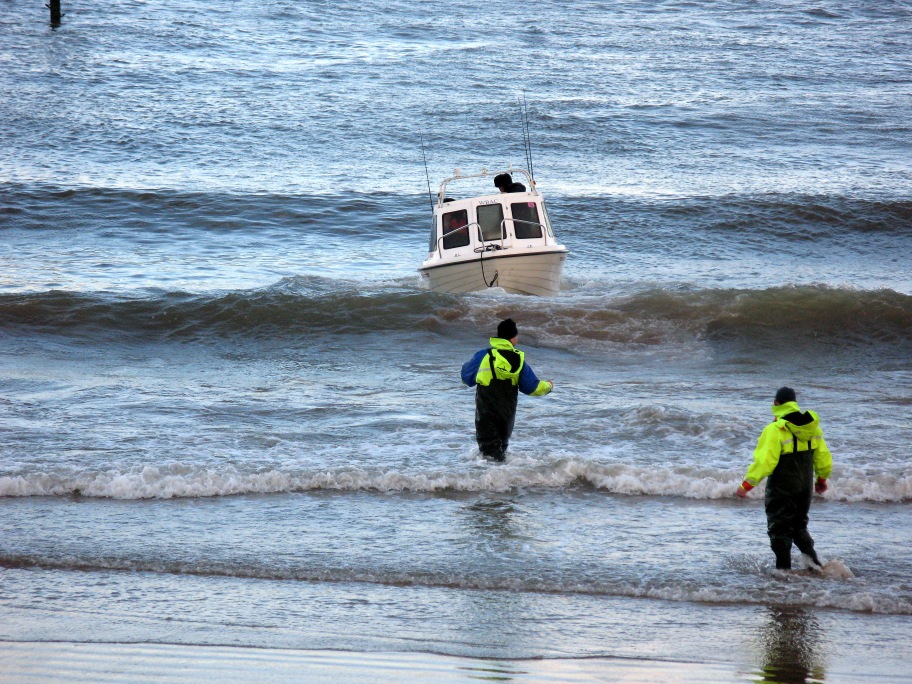Small Boat Ownership - Lauch, Retrieve & Handling

When you reach the waters edge, whether the tide is flooding or ebbing, speed is of the essence, particularly when sea conditions donít make it easy to hold the boat while the trailer is being taken back. A good example of a tricky situation for launching and retrieving is over the high water period, or when youíve been forced to abandon a trip due to deteriorating sea conditions. High water, even in calm conditions, often sees the last roller flopping onto the beach. Holding a boat against the force of a rolling wave can be difficult, particularly if the water is deep as it often where you have a sea wall with waves washing back off it. Further down the beach, especially on an ebbing tide, life gets very much easier, unless of course you insist on keeping the boat afloat in the mistaken belief that it will be too difficult to winch on dry. In a pounding sea, even with a self-centring cradle, winching a floating boat on can see a few problems. Trying to get a keel to run along a row of small rollers spaced out along the spine of a standard trailer can be nigh on impossible as incoming waves pick the boat up then dump it back down on the trailer in the wrong position. Worse still are waves that bounce the boat up and down onto concrete. Far better then to think things through and come in either before or after the tide has gone all the way in if you can. Fishing invariably tails off anyway as the tide dies just before the turn, so thereís often little incentive to carry on when life could be so much easier for getting the boat out if you time it right.
The real secret to successful trailed boat launching is to have a regular crew who knows exactly what is expected of him/her as part of a well-rehearsed routine. In any kind of a swell you need to get the boat off quickly and turned around bow into the waves to prevent taking a few big ones over the stern and swamping the fishing well. Holding it there is another matter, so the trailer needs to be deposited up top as fast as possible so that the boat can be eased away into deeper water where conditions can rapidly improve. So often on an exposed beach towards high water there will be boats out there that launched much earlier in the tide fishing quite comfortably in good conditions, leaving those who arrive later to be faced with the dilemma of launch through the pounding rollers at the edge towards high water, or wait. Invariably, if you do wait, the breakers at the edge do become more manageable. This then begs the question why turn up at an inappropriate time in the first place instead of thinking it through like the anglers already out there have, and those that will turn up in say another hour of so. Once there, and in the knowledge that boats are already out catching fish, the temptation is to launch and be damned. Having tried it on a number of occasions, take it from me, it can be fraught with problems.

Our routine when launching is to fully prepare the boat on top before heading down the slip. The trailer strap is already off. Only the winch strap is holding the boat on the trailer. At the water edge, the tractor turns and pulls away to make ready for reversing in. He stops and the winch strap is disconnected. If we were to reverse in at that point we would run the risk of the boat sliding off prematurely, either into too shallow water or even on to the beach. Not so much of a problem on a making tide, but bad news on the ebb. So what I do is wrap the lazy line (or paynter) around the winch handle a couple of time and keep tension on it. This prevents the boat from sliding off. When the wheels are in the water up to the hubs, the lazy line is released. Dave then steps on the gas reversing in a few yards more then hits the brake hard causing the boat to slide effortlessly off. He then takes off up the beach to park the trailer while I swing the boat around and fire up the outboard. By the time he gets back down the engine is nicely warmed up and away we go. But if its a bit on the lumpy side, I might motor off a few hundred yards then come back in to pick him up when he makes it back down the beach.
Often on lumpy days, though sometimes even when its flat calm, you will see people giving their engines a bit of a run on top because they want to be sure it starts ASAP in the water. Fine if you connect a hose and muffs to get some water circulating around the cooling system. Not so good if the engine is being run completely dry. Running dry causes problems for the impeller inside the leg. This is the little gismo that sucks in and circulates the cooling water. Running dry creates frictional heat at the tips of the impeller blades, which over time leads to mal-functioning. Changing an impeller is quite a big job, even if you can get the propeller off easily. My guess is that the type of person who runs their engine dry also wonít have removed the prop and greased the shaft for ease of removal later. However, if you do want to run your outboard and a hosed water supply isnít available, you can connect the muffs to a barrel full of water perched in the splash well of the boat. A hose-lock connector fitted to the barrel top and a short length of hose will do the trick. I actually use the same barrel that works as the buoy for our Alderney Ring. I have a separate cap with a hose lock connection stashed away in the boat in case I need it. The barrel can be filled using a bucket and seawater, which shouldnít be too far away at high tide when it is most likely to be required.
The launching example quoted earlier was a perfect case scenario in good conditions with the tide well down the beach. In lumpy conditions, and/or at high water, it can be a very different game. On the plus side, the drive back with the trailer won't be as far, so you donít have as long to struggle holding the boat. Standing in already deep water gives you far less control over holding the boat at a time when more control is needed. Warming the outboard up isnít always possible as the leg could make contact with the bottom when dropped to get the water cooling system working. In situations where I can warm the outboard up, if its lumpy, the moment itís warm I motor off a little way into calmer water to wait for Dave then reverse back in to pick him up. Turning a boat in a breaking swell close to the edge, or heading out with an engine that is not fully warmed up and likely to stall or cut out is literally asking for trouble. The moment a boat goes beam on to the rollers, as it will if the engine stalls, it runs the very real risk of getting rolled, or suffering a good swamping at the very least. Once committed you sometimes just have to go with it. This is even truer when coming ashore in nasty conditions. Pick your wave and run with it. No throttling back or changing your mind. Hit the beach hard and jump out quickly to turn the boat. That couple of hundred yards of water adjacent to the beach is always the most dangerous bit. So if you donít routinely wear a life jacket, at least give serious thought to wearing one close in.
Out in deeper water, some of the shoreline problems go away. They are unfortunately replaced by different problems and strategies for dealing with them. The main point to make in terms of open water sea conditions is that unlike close in along the beach where waves like to come in at right angles to the shore, further off the angle they take is usually determined by the direction of the wind. If the wind is light, then it is not going to be a problem. When itís fresh, it can present all sorts of issues made easier or harder depending on where it is you have chosen to fish. If you have sailed south for example and afterwards a fresh southerly breeze kicks up, then you are going to have a much quicker, safer and more comfortable run back than if on the same day you had sailed north. Taking a sea bow on is not a pleasant experience, particularly in an open boat. The throttle invariably needs to be pulled back. When running into a really bad sea, it isnít only the boat and its contents that can suffer from the physical hammering. There is going to be a lot of water flying about too. Maybe even waves breaking over the roof if you get caught out really badly. Running with a nasty following sea can also be a heart in the mouth experience, particularly in a small boat with not a lot of power. Surfing down a big angry wave can leave you wondering what will happen when you get to the bottom. Will the boat swerve to one side or other with the risk of being rolled. At least with a reserve of power you can prevent this from happening by keeping the boat running straight.

Running beam on to a nasty sea can be both un-nerving and uncomfortable, not to mention potentially dangerous. Fortunately, most boats are able to take far worse conditions than their owners. A sort of built in fail-safe if you like. Not that you should deliberately ever try to push a boat to its absolute limit, though there may be times when you will have no choice, for there will be times when you simply get caught out, and not always by speed of change or a forecast that is well short of the mark. I once had a 16 foot open boat with a 4 hp seagull on the back for a couple of days haddock fishing at Lamlash on the Isle of Arran. On day one it was lumpy going up the sound at the side of Holy Island. But as we rounded the tip and turned we got instant shelter from the cliffs. With lots of fish to show for our efforts and an identical forecast for day two, we again battled our way up to the point only to find that the wind angle had changed slightly and the cliffs offered no shelter. If anything it was worse. And with no where to land on the island, we had to run for miles in a huge following sea expecting to roll with every new wave. Eventually we made it around the bottom corner into shelter. But it was touch and go. In the kind of boats we run today with better sea worthiness and more power, I would have tacked at an angle first one way for a few hundred yards then the other. It takes longer, but tacking is certainly one way of not having to take waves at an angle either on the stern or on the bow.
The obvious solution here would be to keep yourself right up to date with the weather forecast. A quick radio call to your local coastguard is a prime source of current coastal weather and short-term predictions. If the forecast is for the wind to get up from the south as mentioned earlier, then you should consider heading south even if it isnít really where you want to go. Obviously, wind strength as well as direction is another factor in the equation. Something of the order of force 2 to 3 shouldnít really bother to a 16 foot boat with a cuddy, though it could in areas with specific tidal problems such as tide rips over banks or reefs, around headlands, and between islands. Thatís one you will have to sort out for yourself with a good input of local knowledge. The other major consideration determining where it might be best to go when the breeze is predicted at getting up to a 4 or even 5 is the wind direction in relation to the timing of your trip. A good stiff wind blowing in exactly the opposite direction to a fair lick of tide could be asking for trouble. So you need to know tidal directions in your area. Just because water travels in and out up and down the beach doesnít mean that is the way it is actually running. Take my local patch. The beach at Blackpool faces more or less due west, so the water on the beach moves east when flooding, and west on the ebb. But the actual tide flow is north on the flood and south on the ebb. On a fresh northerly we are better fishing an ebbing tide with wind and tide both going in the same direction.
In any kind of a dodgy forecast, when fishing from an open stretch of shoreline with no peculiar local reason to do otherwise, it is advisable to fish an ebbing tide. Along the Fylde coast where the water can get right up to the concrete sea defences, this is especially true. The reason is that if things suddenly deteriorate when its already a marginal decision whether to fish or not, you want to be sure that you have some exposed beach to run in onto. Even at venues where there are no concrete sea defences, the slope of the beach usually means that there will be rollers at the edge at high water. Okay, so there will be breaking waves at the edge from mid tide all the way down to low water too. The difference is that where the beach is flatter, they are less likely to threaten the boat it terms of swamping or rolling it, and getting it back onto the trailer will be a whole lot easier too. If you get caught out on a making tide, particularly towards high water, you may well have to tough it out for a couple of hours until it pulls far enough back after the turn to make it safe enough to get in. This happened off our coast some years ago when a number of dinghies were caught out by a sudden and particularly nasty turn in the weather towards high water. With nowhere close to the fishing marks exposed to come ashore, the boats ran for the south shore where they knew they could find some sand. This unfortunately left them running beam on to some horrendous conditions with disastrous results. Sadly, not everybody made it back that day.
SEE THE VIDEO VAULT Ė Dinghy afloat